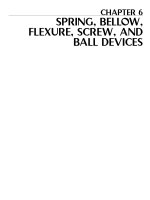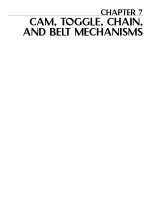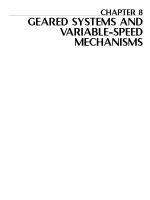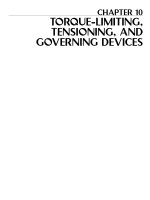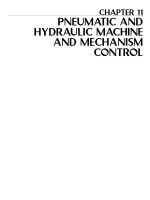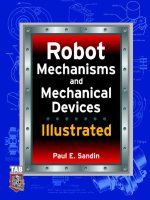Mechanisms and Mechanical Devices Sourcebook - Chapter 11
Bạn đang xem bản rút gọn của tài liệu. Xem và tải ngay bản đầy đủ của tài liệu tại đây (1.81 MB, 35 trang )
Sclater Chapter 11
5/3/01
1:15 PM
Page 369
CHAPTER 11
PNEUMATIC AND
HYDRAULIC MACHINE
AND MECHANISM
CONTROL
Sclater Chapter 11
5/3/01
1:15 PM
Page 370
DESIGNS AND OPERATING PRINCIPLES OF
TYPICAL PUMPS
These pumps are used to transfer liquids and supply hydraulic power.
1. WITH BUT TWO MOVING PARTS, the rotors that turn in the same direction, this
rotary pump has reduced friction to a minimum. The rotors rotate against flexible synthetic rubber cushions that allow sand, grit and other abrasives to flow freely through the
pump without damage. It is a positive displacement pump that develops a constant pressure and will deliver a uniform flow at any given speed. The pump is reversible and can
be driven by a gasoline engine or electric motor. The rubber cushions withstand the
action of oil, kerosene, and gasoline, and the pump operates at any angle. It has been used
in circulating water systems, cutting tool coolant oil systems and general applications.
3. BASED on the swinging vane principle, this pump maintains its volumetric
efficiency automatically. The action of
the buckets, fitted loosely into recesses in
the rotor, compensates for wear. In operation, the tip of the bucket is in light contact with the casing wall. Liquids are
moved by sucking and pushing actions
and are not churned or foamed.
370
2. PUMPING ACTION is produced by
the meshing of the idler and rotor teeth in
this rotary pump. The idler is pinmounted to the head and the rotor operates in either direction. This pump will
not splash, foam, churn or cause pounding. Liquids of any viscosity that do not
contain grit can be transferred by this
pump which is made of iron and bronze.
4. HIGH-PRESSURE, high-volume pumps of the axial piston, constant displacement type are rated at 3,500 psi for continuous duty operation; higher pressure is permissible for intermittent operation. A pressure-balanced piston shoe lubricates the
cam plate and prevents direct contact between the shoe and cam plate. The use of the
pressure balanced system removes the need for thrust bearings. The two-piece shaft
absorbs deflection and minimizes bearing wear. The pump and electric driving motor
are connected by a flexible coupling. The revolving cylinder barrel causes the axial
reciprocation of the pumping pistons. These pumps only pump hydraulic fluids.
Sclater Chapter 11
5/3/01
1:15 PM
Page 371
5. THE GEAR SHAFTS of this hydraulic gear pump are
mounted on tapered roller bearings that accurately position the
gears, decrease end play, and reduce wear to a minimum. This
heavy-duty gear pump can be used at pressures up to 1,000 psi.
These pumps were made with either single- or double-end
shafts and can be foot- or flange-mounted. The drive shaft
entrance packing is made from oil-resistant material, and the
gear shafts are made from hardened molybdenum steel.
7. This pump is characterized by its pedestal mounting. The
only non-critical fit is between the pedestal casting and the casing. Positive alignment is obtained because the sealed ball bearings and the shaft are supported in the single casting. The fivevaned, open, bronze impeller will move liquids that contain a
high volume of solids. The pump is not for use with corrosive
liquids. The five models of this pump, with ratings up to 500
gpm, are identical except for impeller and casing sizes.
6. THIS HIGH-PRESSURE hydraulic pump has twin pistons
that build pressures from 100 to 4,000 psi at speeds from 600 to
1,200 rpm. This pump can be operated continuously at 900 rpm
and 2,500 psi with 1.37 gpm delivered. Because it can be
mounted at any angle, and because it is used with small oil
lines, small diameter rams and compact valves, the pump is
suitable for installation in new equipment. This pump contains
a pressure adjusting valve that is factory set to bypass at a predetermined pressure.
8. USED TO TRANSFER, meter, or proportion liquids of high
or low viscosity, this pump is a positive displacement gear
pump. It is made of stainless steel with a stainless steel
armored, automatic take-up, shaft seal of the single-gland type.
Automatic wear control compensates for normal wear and
maintains volumetric efficiency. This pump will handle 5 to
300 gph without churning or foaming. It needs no lubrication
and operates against high or low pressure.
371
Sclater Chapter 11
5/3/01
1:15 PM
Page 372
These pumps are used to transfer liquids and semisolids,
pump vacuums, and boost oil pressure
9. ORIGINALLY DESIGNED for use in
the marine field, this gearless pump was
made from stainless steel, monel, and
bronze for handling acids, oils, and solvents. The impeller is made of pressurevulcanized laminated layers of Hycar, 85 to
90 percent hard. Sand, grit, scale and
fibrous materials will pass through. With
capacities from 1 to 12 gpm and speeds
from 200 to 3,500 rpm, these pumps will
deliver against pressures up to 60 psi. Not
self-priming, it can be installed with a reservoir. It operates in either direction and is
self-lubricating.
11. DEFLECTED BLADES of the flexible
neoprene impeller straighten as they leave
contact with offset plate. The high suction
created draws fluid into pump, filling space
between the blades. It handles animal, vegetable, and mineral oils but not napthas,
gasoline, ordinary cleaning solvents, or paint
thinners. The pump operates in either direction and can be mounted at any angle. It runs
at 100 to 2,000 rpm, can deliver up to 55
gpm, and will operate against 25 psi. It operates at temperatures between 0 and 160 F.
372
10. THE SQUEEGEE PUMP consists of a U-shaped flexible tube made of rubber, neoprene, or other flexible material. Acids and corrosive liquids or gases pass through the tube
and do not contact working parts or lubricating oil. This prevents contamination of the liquid and avoids corrosion of metal parts. In operation, the tube is compressed progressively
from the intake side to the discharge side by cams mounted on a driven shaft. Compression
blocks move against the tube, closing the tube gradually and firmly from block to block,
which forces the liquid out. As the cam passes the compression blocks, the tube returns to
its original diameter. This creates a high vacuum on the intake side and causes the tube to
be filled rapidly. The pump can be driven clockwise or counter-clockwise. The tube is
completely encased and cannot expand beyond its original diameter. The standard pump is
made of bronze and will handle volumes to 15 gpm. The Squeegee develops a vacuum of
25 in. of mercury and will work against pressures of 50 lb/in2.
12. THIS PUMP CAN TRANSFER free-flowing liquids, non-pourable pastes, clean or
contaminated with abrasives, chemically inert or active, homogeneous or containing
solids in suspension. It is a positive displacement pump that delivers continuous, uniform flow. The one moving part, a low-alloy or tool-steel rotor, is a single helix, and the
Hycar or natural rubber stator is a double internal helix. Pumping action is similar to that
of a piston moving through a cylinder of infinite length. Containing no valves, this pump
will self-prime at 28 ft of suction lift. The head developed is independent of speed, and
capacity is proportional to speed. Slippage is a function of viscosity and pressure, and is
predictable for any operating condition. The pump passes particles up to 7⁄8 in. diameter
through its largest pump. Pumping action can be in either direction. The largest standard
pump, with two continuous seal lines, handles 150 gpm up to 200 psi.
Sclater Chapter 11
5/3/01
1:15 PM
Page 373
13. HIGH-VACUUM PUMPS operate with
the rotating plunger action of liquid pumps.
Sealing oil lubricates the three moving parts.
Parts are accessible without disturbing connected piping. These pumps are used to
rough pump a vacuum before connecting a
diffusion pump; to evacute light bulbs and
electronic tubes, and to vacuum dry and distill. Single pumps draw vacuums from 2 to 5
microns; in series to 0.5 micron, and compound pumps draw to 0.1 micron. They can
be run in reverse for transferring liquids.
Diagonal cored slots, closed by a slide pin,
form the passageway and inlet valve. Popper
or feature outlet valves are used.
15. THIS SELF-PRIMING PUMP gives a
rapid and smooth transition from priming
cycle to centrifugal pumping. The pump
starts with its priming chamber full. Liquid is
recirculated through the impeller until the
pump is primed. As priming liquid circulates, air is drawn through impeller and
expelled through the discharge. When all air
is evacuated, discharge velocity closes the
priming valve completely. These pumps can
have open or closed impellers. Solids up to 1
in. can be passed through a 3 in. size pump
with an open impeller.
14. A COMPACT MULTI-PLUNGER INTENSIFIER, this hydraulic booster is
designed to convert low pressure to high pressure in any oil-hydraulic circuit. No
additional pumps are required. Because of its six plungers, the pressure flow from
the booster is both smooth and uninterrupted. High-pressure pumps are not
required, and no operating valves are needed to control the high-pressure system.
Small cylinder and ram assemblies can be used on operating equipment because the
pressure is high. Operating costs can be low because of the efficient use of connected horsepower. The inertia effects of the small operating rams are low, so high
speed operations can be attained. These boosters were built in two standard sizes,
each of which was available in two pressure ranges: 2 to 1 and 3 to 1. Volumetric
output is in inverse proportion to the pressure ratio. All units have a maximum
7,500 psi discharge pressure. Pistons are double-acting, and the central valve
admits oil to pistons in sequence and is always hydraulically balanced.
16. INTERNAL SCREW PUMPS can easily transfer high-viscosity petroleum
products. They can be used as boiler fuel pumps because they deliver a pulseless
flow of oil. For marine or stationary systems, the characteristic low vibration of
screw pumps has allowed them to be mounted on light foundations. The absence
of vibration and pulsing flow reduces strain on pipes, hose and fittings. The
pumping screws are mounted on shafts and take in liquid at both ends of the pump
body and move it to the center for discharge. This balanced pumping action
makes it unnecessary to use thrust bearings except in installations where the
pump is mounted at a high angle. The pumps can be used at any angle up to vertical. Where thrust bearings are needed, antifriction bearings capable of supporting
the load of the shaft and screws are used. The intermeshing pumping screws are
timed by a pair of precision-cut herringbone gears. These are self-centering, and
do not allow the side wear of the screws while they are pumping. The pump is
most efficient when driven less than 1,200 rpm by an electric motor and 1,300
rpm by a steam turbine.
373
Sclater Chapter 11
5/3/01
1:15 PM
Page 374
ROTARY-PUMP MECHANISMS
Fig. 1 (A) A Ramelli pump with spring-loaded vanes to ensure contact with the wall; vane ends are rounded for line contact. (B) Two
vanes pivot in the housing and are driven by an eccentrically
mounted disk; vanes slide in glands and are always radial to the
Fig. 2 Flexible vanes on an eccentric rubber rotor displace liquid as in sliding-vane
pumps. Instead of the vanes sliding in and
out, they bend against the casing to perform pumping.
housing, thus providing surface contact. (C) A housing with a cardioid
curve allows the use of a single vane because opposing points on the
housing in line with the disk center are equidistant.
Fig. 3 A disk mounted eccentrically on
the drive shaft displaces liquid in continuous flow. A spring-loaded gland separates
the inlet from the outlet except when the
disk is at the top of stroke.
Fig. 4 A rotary compressor pump has a
link separating its suction and compression
sides. The link is hinged to a ring which
oscillates while it is driven by the disk.
Oscillating action pumps the liquid in a continuous flow.
Fig. 5 A gear pump transports liquid
between the tooth spaces and the housing
wall. A circular tooth shape ha sonly one tooth
making contact, and it is more efficient than an
involute shape which might enclose a pocket
between two adjoining teeth, recirculating part
of the liquid. The pump has helical teeth.
Fig. 7 A three-screw pump drives
liquid between the screw threads along
the axis of the screws. The idle rotors
are driven by fluid pressure, not by
metallic contact with the power rotor.
374
Fig. 6 A Roots compressor has two
identical impellers with specially shaped
teeth. The shafts are connected by external
gearing to ensure constant contact between
the impellers.
Sclater Chapter 11
5/3/01
1:15 PM
Page 375
Fig. 8 The housing of the HeleShaw-Beachum pump rotates the
round-cranked shaft. Connecting
rods attached to the crank ring
cause the pistons to oscillate as the
housing rotates. No valves are necessary because the fixed hollow
shaft, divided by a wall, has suction
and compression sides that are
always in correct register with the
inlet and outlet ports.
Fig. 9 A disk drives the oscillating arm which
acts as piston. The velocity of the arm varies
because of its quick-return mechanism. Liquid is
slowly drawn in and expelled during the clockwise
rotation of the arm; the return stroke transfers the
liquid rapidly.
Fig. 10 A rotating cylinder block is mounted concentrically
in a housing. Connecting-rod ends slide around an eccentric
guide as the cylinders rotate and cause the pistons to reciprocate. The housing is divided into suction and compression
compartments.
Fig. 11 A rotary-reciprocating pump that is normally operated
manually to pump high-viscosity liquids such as oil.
OFFSET PLANETARY GEARS INDUCE ROTARY-PUMP ACTION
Two planetary gears are driven by an offset sun gear to provide the pumping action in this positive-displacement pump. A successively
increasing/decreasing (suction/compression) is formed on either side of the sun and planet gears.
375
Sclater Chapter 11
5/3/01
1:16 PM
Page 376
MECHANISMS ACTUATED BY PNEUMATIC OR
HYDRAULIC CYLINDERS
Fig. 1 A cylinder can be used with a firstclass lever.
Fig. 4 A cylinder can be linked up directly
to the load.
Fig. 2 A cylinder can be used with a second-class lever.
Fig. 3 A cylinder can be used with a
third-class lever.
Fig. 5 A spring reduces the thrust at the
end of the stroke.
Fig. 6 The point of application of force
follows the direction of thrust.
Fig. 7 A cylinder can be used with a bent
lever.
Fig. 10 A toggle can be actuated by the
cylinder.
376
Fig. 8 A cylinder can be used with a
trammel plate.
Fig. 9 Two pistons with fixed strokes
position the load in any of four stations.
Fig. 11 The cam supports the load after
the completion of the stroke.
Fig. 12 Simultaneous thrusts in two different directions are obtained.
Sclater Chapter 11
5/3/01
1:16 PM
Page 377
(Note: In place of cylinders, electrically powered thrust units or
solenoids can be used.)
Fig. 13 A force is transmitted by a cable.
Fig. 14 A force can be modified by a system of pulleys.
Fig. 17
A rack turns the gear sector.
Fig. 15 A force can be modified by
wedges.
Fig. 18 The motion of a movable rack is
twice that of the piston.
Fig. 16 A gear sector moves the rack
perpendicular to the piston stroke.
Fig. 19 A torque applied to the shaft can
be transmitted to a distant point.
Fig. 20 A torque can also be applied to a
shaft by a belt and pulley.
Fig. 22 A steep screw nut produces a
rotation of the shaft.
Fig. 23 A single-sprocket wheel produces rotation in the plane of motion.
Fig. 21 A motion is transmitted to a distant point in the plane of motion.
Fig. 24 A double-sprocket wheel makes
the rotation more nearly continuous.
377
Sclater Chapter 11
5/3/01
1:16 PM
Page 378
FOOT-CONTROLLED BRAKING SYSTEM
This crane braking system (see figure) operates when the main
line switch closes. The full depression of the master-cylinder
foot-pedal compresses the brake-setting spring mounted on the
hydraulic releasing cylinder. After the setting spring is fully compressed, the hydraulic pressure switch closes, completing the
electric circuit and energizing the magnetic check valve. The setting spring remains compressed as long as the magnetic check
valve is energized because the check valve traps the fluid in the
hydraulic-releasing cylinder. Upon release of the foot peal, the
brake lever arm is pulled down by the brake releasing spring,
thus releasing the brake shoes.
LINKAGES ACTUATE STEERING IN A TRACTOR
Hydraulic power for operating the brakes,
clutch, and steering of a 300 hp diesel-powered
tractor is supplied by an engine-driven pump
delivering 55 gpm at 1200 psi. The system is
designed to give a 15-gpm preference to the
steering system. The steering drive to each
wheel is mechanical for synchronization, with
mechanical selection of the front-wheel, fourwheel or crab-steering hookup; hydraulic
power amplifies the manual steering effort.
378
Sclater Chapter 11
5/3/01
1:16 PM
Page 379
FIFTEEN JOBS FOR PNEUMATIC POWER
Suction can feed, hold, position, and lift parts, form plastic
sheets, sample gases, test for leaks, convey solids, and
de-aerate liquids. Compressed air can convey materials, atomize
and agitate liquids, speed heat transfer, support combustion,
and protect cable.
379
Sclater Chapter 11
5/3/01
1:16 PM
Page 380
15 Jobs for Pneumatic Power (continued )
TEN WAYS TO USE METAL DIAPHRAGMS AND
CAPSULES
A metal diaphragm is usually corrugated (Fig. 1) or formed to some irregular profile. It can be
used as a flexible seal for an actuating rod. The capsule (Fig. 2) is an assembly of two
diaphragms sealed together at their outer edges, usually by soldering, brazing, or welding. Two
or more capsules assembled together are known as a capsular element (Fig. 3). End fittings
for the capsules vary according to their function; the “fixed end” is fixed to the equipment. The
“free end” moves the related components and linkages. The nested capsule (Fig. 4) requires
less space and can be designed to withstand large external overpressures without damage.
380
Sclater Chapter 11
5/3/01
1:16 PM
Page 381
A differential pressure gage (Fig. 5) with opposing capsules can have either single or multicapsular elements.
The multicapsular type gives greater movement to the
indicator. Capsules give improved linearity over bellows
for such applications as pressure-measuring devices. The
force exerted by any capsule is equal to the total effective
area of the diaphragms (about 40% actual area) multiplied
by the pressure exerted on it. Safe pressure is the maximum pressure that can be applied to a diaphragm before
hysteresis or set become objectionable.
An absolute pressure gage (Fig. 7)
has an evacuated capsular element
inside an enclosure that is connected
to the pressure source only. The
diaphragm allows the linkage movement from the capsule to pass
through a sealed chamber. This
arrangement can also be used as a
differential pressure gage by making
a second pressure connection to the
interior of the element.
A capsule pressure-seal (Fig. 9) works like a
thermometer system except that the bulb is
replaced by a pressure-sensitive capsule. The
capsule system is filled with a liquid such as silicone oil and is self-compensating for ambient and
operating temperatures. When subjected to external pressure changes, the capsule expands or
contracts until the internal system pressure just
balances the external pressure surrounding the
capsule.
A pressure gage (Fig. 6) has a capsular
element linked to a dial indicator by a threebar linkage. Such a gage measures pressure or vacuum relative to prevailing atmospheric pressure. If greater angular motion of
the indicator is required than can be
obtained from the three-bar linkage, a quadrant and gear can be substituted.
An expansion compensator (Fig. 8) for oil-filled systems
takes up less space when the capsules are nested. In this
application, one end of the capsule is open and connected
to oil in the system; the other end is sealed. Capsule
expansion prevents the internal oil pressure from increasing dangerously from thermal expansion. The capsule is
protected by its end cover.
A force-balanced seal (Fig. 10) solves the problem, as in the seal of Fig. 9, for
keeping corrosive, viscous or solids-bearing fluids out of the pressure gage. The
air pressure on one side of a diaphragm is controlled so as to balance the other
side of the diaphragm exactly. The pressure gage is connected to measure this
balancing air pressure. The gage, therefore, reads an air pressure that is always
exactly equal to the process pressure.
381
Sclater Chapter 11
5/3/01
1:16 PM
Page 382
DIFFERENTIAL TRANSFORMER SENSING DEVICES
Gage pressure bellows transmitter. The bellows is connected to
a cantilever beam with a needle bearing. The beam adopts a different
position for every pressure; the transformer output varies with beam
position. The bellows are available for ranges from 0–10 in. to 0–200
in. of water for pressure indication or control.
Absolute pressure bellows transmitter. This transmitter is similar
to the differential diaphragm transmitter except for addition of a reference bellows which is evacuated and sealed. It can measure negative gage pressures with ranges from 0–50 mm to 0–30 in. of mercury. The reference bellows compensates for variations in
atmospheric pressure.
Absolute pressure Bourdon-tube transmitter. This device can
indicate or control absolute pressures from 15 to 10,000 psi, depending on tube rating. The reference tube is evacuated and sealed, and
compensates for variations in atmospheric pressure by changing the
output of the reference differential transformer. The signal output consists of the algebraic sum of the outputs of both the primary and reference differential transformers.
382
Differential diaphragm pressure transmitter. Differential pressures P1 and P2 act on the opposite sides of a sensitive diaphragm
and move the diaphragm against the spring load. The diaphragm displacement, spring extension, and transformer core movement are
proportional to the difference in pressure. The device can measure
differentials as low as 0.005 in. of water. It can be installed as the primary element in a differential pressure flowmeter, or in a boiler windbox for a furnace-draft regulator.
Cantilever load cell. The deflection of a cantilever beam and the
displacement of a differential transformer core are proportional to the
applied load. The stop prevents damage to the beam in the event of
overload. Beams are available for ranges from 0–5 to 0–500 lb. And
they can provide precise measurement of either tension or compression forces.
Proving ring. The core of the transmitting transformer, T1, is fastened to the top of the proving ring, while the windings are stationary.
The proving ring and transformer core deflect in proportion to the
applied load. The signal output of the balancing transformer, T2,
opposes the output of T1, so that at the balance point, the null point
indicator reads zero. The core of the balancing transformer is actuated
by a calibrated micrometer that indicates the proving ring deflection
when the differential transformer outputs are equal and balanced.
Sclater Chapter 11
5/3/01
1:16 PM
Page 383
Gaging and callipering. The thickness of a moving wire or strip is
gaged by the position of the floating spool and transformer core. If
the core is at the null point for proper material thickness, the transformer output phase and magnitude indicate whether the material is
too thick or thin and the amount of the error. The signal can be ampli-
Flow meter. The flow area varies as the float rises or falls in the tapered
tube. High flows cause the float to rise, and low flows cause it to drop. The
differential transformer core follows the float travel and generates an AC signal which is fed into a square-root recorder. A servo can be equipped with a
square root cam to read on a linear chart. The transformer output can also
be amplified and used to actuate a flow regulating valve so that the flowmeter becomes the primary element in a flow controller. Normally meter accuracy is better than 2%, but its flow range is limited.
fied to operate a controller, recorder, or indicator. The device at the
right can function as a production caliper or as an accurate micrometer. If the transformer output is fed into a meter indicator with go and
no-go bands, it becomes a convenient device for gaging items.
Tension control. The loading spring can be adjusted so that
when the transformer core is at its null point, the proper tension is
maintained in the wire. The amplified output of the transformer is
transmitted to some kind of tension-controlling device which
increases or reduces the tension in the wire, depending on the
phase and magnitude of the applied differential transformer signal.
383
Sclater Chapter 11
5/3/01
1:16 PM
Page 384
HIGH-SPEED COUNTERS
The electronic counter counts electrical
pulses and gives a running display of
accumulated pulses at any instant.
Because the input is an electrical signal,
a transducer is generally required to
transform the nonelectrical signal into a
usable input for the counter.
With a preset function on the counter,
any number can be selected within the
count capacity of the device. Once the
counter reaches the preset number, it can
open or close the relay to control some
operation. The counter will either reset
automatically or stop. A dual unit permits
continuous control over two different
count sequence operations. Two sets of
predetermining switches are usually
mounted on the front panel of the
counter, but they can be mounted at a
remote location. If two different numbers
are programmed into the counter, it will
alternately count the two selected numbers. Multiple presets are also available,
but at higher cost.
In addition to performing two separate operations, a dual preset can control
speeds, as shown in Fig. 1. In the metal
shearing operation run at high speed, one
preset switch can be used to slow the
material down at a given distance before
the second preset actuates the shearing.
Then both switches automatically reset
and start to measure again. The same presets could also be used. The same presets
could also be used to alternately shear
the material into two different lengths.
One form of measurement well
adapted to high-speed counters is the
measuring of continuous materials such
as wire, rope, paper, textiles, or steel.
Fig. 2 shows a coil-winding operation in
which a counter stops the machine at a
predetermined number of turns of wire.
A second application is shown in Fig.
3. Magazines are counted as they run off
a press. A photoelectric pickup senses the
alternate light and dark lines formed by
the shadows of the folded edges of the
magazines. At the predetermined number, a knife edge, actuated by the counter,
separates the magazines into equal
batches.
A third application is in machine-tool
control. A preset counter can be paired
with a transducer or pulse generator
mounted on the feed mechanism. It
could, for example, convert revolutions
of screw feed, hence displacement, into
pulses to be fed into the counter. A feed
of 0.129 in. might represent a count of
129 to the counter.
When preset at that number, the
counter could stop, advance, or reverse
the feed mechanism.
384
Fig. 1 A dual preset function on a high-speed counter controls the high-speed
shearing operation. If the material is to be cut in 10-ft lengths and each pulse of the
electromagnetic pickup represents 0.1 ft, the operator presets 100 into the first input
channel. The second input is set to 90. When 90 pulses are counted, the second
channel slows the material. Then when the counter reaches 100, the first channel
actuates the shear. Both channels reset instantaneously and start the next cycle.
Fig. 2 A coil-winding machine with electronic counting for measuring length.
Fig. 3 A magazine counter has a
sharply focused photoelectric pickup
that counts magazines. The photocell
senses the alternate light and dark lines
as the folded edges of the magazines
cast their shadows. The counter actuates the knife edge to separate the magazines into equal batches when the predetermined count is reached.
Sclater Chapter 11
5/3/01
1:16 PM
Page 385
DESIGNING WITH PERMANENT MAGNETS
Fig. 1 The simplest form
of permanent magnet is a
bar that has two poles
which can have any cross
section.
Fig. 3 A cylindrical magnet can be magnetized with as
many pairs of poles as desired on the outside diameter
as in (A) or the inner diameter as in (B). Also, they can
be made nonsalient (A) or salient (B).
Fig. 2 U or C-shaped permanent magnets are cast
that way to bring both of
the pole faces into the
same plane.
Fig. 4 This magnetic roll for material separators is made from magnets and steel pole
pieces that supply an equal magnetic field
on 360º of the pole surface.
Fig. 5 Magnets for generators and other machines can be assembled from multiple magnets with
laminated (A) or solid pole pieces (E), cast with inserts for pressing in shafts, nonsalient (B) or salient
(C) or cast for assembly on shafts (D).
Fig. 6 Stator or internal pole assembles using steel pole faces and magnets are
made in various ways depending on the mechanical space, magnetic and physical
characteristics required.
Fig. 7 A four-pole magnet is shown with steel pole pieces, but it is possible to incorporate as many poles as are required (A) using bar magnets. In style (B) it is possible
to obtain several poles by using one two-pole magnet.
Fig. 8 These permanent magnet assembles have double air gap. (A) has no steel
poles, but (B) has them.
385
Sclater Chapter 11
5/3/01
1:16 PM
Page 386
Designing with Permanent Magnets (continued )
Fig. 9 Fixed air-gap magnets can be made from
a multiplicity of magnets without steel pole pieces
(A), or with pole pieces (B) and (C).
Fig. 10 Simple fixed air-gap magnets can be without
pole pieces (A) or with pole pieces (B) and (C).
Fig. 11 Annular air gaps are useful in instruments and loudspeakers. The magnets can be
(A) plug, (B) cylindrical, or (C) ring-type, depending upon the application.
Fig. 12 Soft steel bars are used to complete the magnetic circuit, allowing maximum flux density through the
air gap. The arrangement can use single magnets (A),
(B), or double magnets (C), (D), (E), or a single magnet
with a shunt (F).
Fig. 13 Special magnets are cast for microwave power tubes—threepole E style (A), and concentric-gap bowl type (B). Many other forms
are possible.
386
Sclater Chapter 11
5/3/01
1:16 PM
Page 387
PERMANENT MAGNET
MECHANISMS
Fig. 1 A suspension.
Fig. 2 Tension devices.
Fig. 4 An instrument coupling.
Fig. 3 A reel brake.
Fig. 5 A crankcase oil drain plug.
Fig. 6 A non-rattling door latch.
387
Sclater Chapter 11
5/3/01
1:16 PM
Page 388
Permanent Magnet Mechanism (continued )
Fig. 8 A snap-action switch.
Fig. 7 A clamp.
Fig. 9 An instrument holder.
Fig. 10 An escape wheel.
Fig. 11 A pressure release.
388
Fig. 12
A filter.
